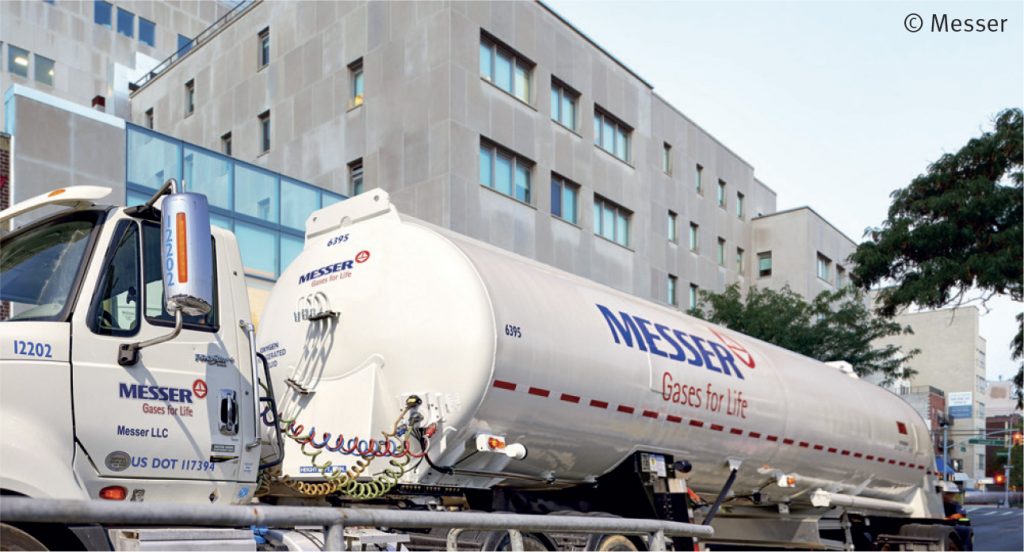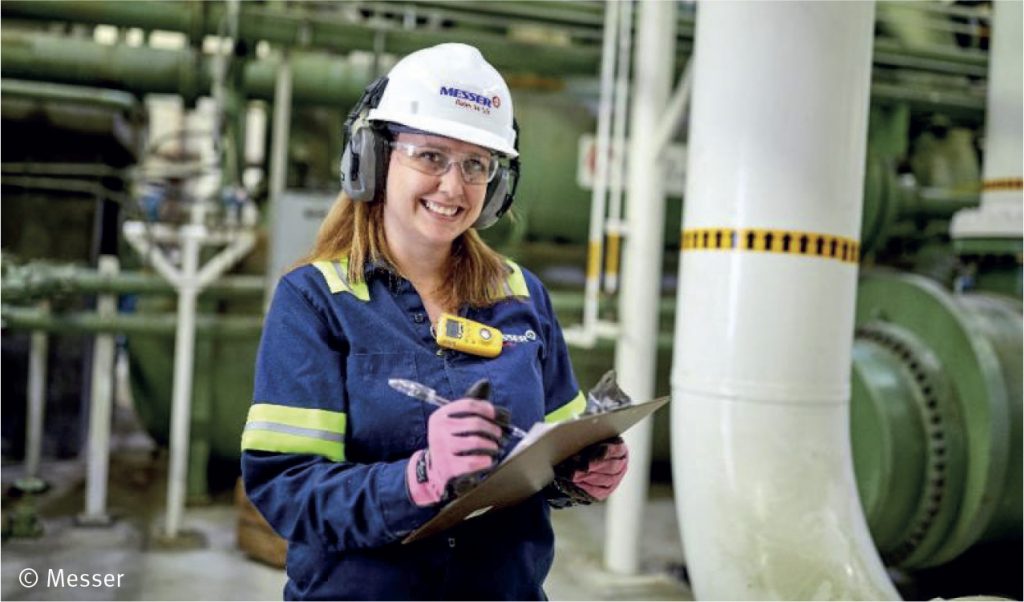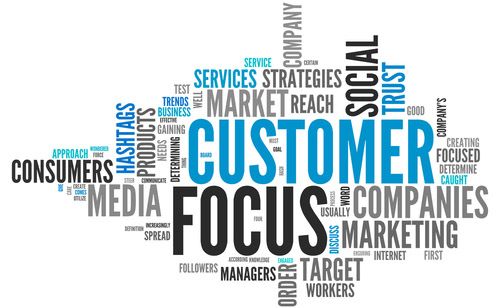Thanks to Chris Ebeling (Executive Vice-President of Sales & Marketing, US Bulk, Messer Americas) his contribution. The content for this blog was published in the October 2020 US Print edition of GasWorld.
Balancing customer focus and efficiency is absolutely essential for any company that desires to maximize its ability to attract, serve and retain customers through the various economic cycles. Covid-19 has taught us that companies that were ‘deficient’ on one or both of these two aspects are prone to suffering severe pain during the pandemic. As a matter of fact, many are now trying to institute improvements to repair or regain lost customer confidence and/or market share.
Therefore, this article focuses on the strategy and tactics that organizations should employ to better balance customer focus and efficiency.
The ideal organizational mindset of customer focus must extend beyond the typical Customer Service function or Order-to-Cash processes and encompass all those in the organization who have touchpoints with external customers. Keeping all these internal organizations focused on the customer, efficiently,
is the challenge of our industry. The smaller you are the easier it is, but as you grow and scale your business, the challenge of balancing customer focus with efficiency becomes a bigger and bigger challenge.
Trends and challenges
The concept of customer focus expanded rapidly due to the advent of the Internet. In essence, the internet provides more ability to shop and compare suppliers. For example, the creation of tools/metrics to measure customer satisfaction/loyalty, blogs, third-party
scoring services, and the advance of
computer platforms to help companies
collect and manage information
on suppliers (vendor relationship
management systems, for example) all
strengthen the position of the purchaser.
The same is true for the suppliers and how they can evaluate the customers. They have real-time credit ratings, information on auctions, customer satisfaction scoring, and more. Retail and business-to-consumer (B2C) companies were the early adopters that helped drive this concept forward. Within a decade or so, momentum started building within business-to- business (B2B) companies, which included industrial gases, and they gradually adopted many of the same concepts with a few nuances.
Today, one of the biggest trends around driving customer focus is the concept of Customer Experience (CX). One definition of B2B CX is the overall experience a customer has with a company across all points of interactions – before, during and after purchase/ renewal. I specifically mention ‘B2B’ CX because it is different and more nuanced than B2C. Longer sales cycles, educated users/buyers, multiple decision-makers, thorough vetting before buying, larger stakes on account renewal and many others are just some of the unique aspects with which B2B CX planners have to be aware.
Employing digital and automated solutions has allowed Messer
to improve many aspects…
McKinsey has stated that investing in improved CX pays dividends. These improvements can lower customer churn by 10-15%, increase the win rate of offers by 20-40%, and lower the costs to serve by up to 50%.
Within CX, one of the larger trends is understanding the critical journeys that customers are having with you and your products/services. Most B2B companies, both within and outside of the industrial gases industry, have 5-8 key journeys that shape the customer experience and cover the customer life cycle end-to-end. Examples include identifying/choosing the right products and services, selecting a supplier, and making the first purchase. Understanding these critical journeys and then beginning to execute them flawlessly and pain-free for customers is the first step.
The final trend that is improving customer focus more efficiently is the use of digitalization. Digital technology trends such as social media, mobile, Industrial Internet of Things (IIOT) are already being employed in our industry in the areas below:
- Liquid/bulk and packaged gas supply chain optimization
- Remote operating centers (ROCs)
- Remote maintenance support
- Automation of package gas operations
- E-commerce/online presence
- Customer care/service.
Employing digital and automated solutions has allowed Messer to improve many aspects of both the customer experience and our cost to reliably supply,
Chris Ebeling, Executive Vice-President of Sales & Marketing, US Bulk, Messer Americas.
These solutions, along with others, enable those critical customer journeys in an efficient, ‘pain-free’ and almost invisible fashion. In another McKinsey survey of 1,000 B2B decision-makers, lack of speed in interactions with their suppliers emerged as the number-one ‘pain point’, mentioned twice as often as price. Obviously, price is extremely important, but lack of responsiveness almost always drives customers to explore alternatives.

Balancing considerations
As we know, the mantra or slogan of ‘the customer is always right’, started by pioneers in the retail space in the early 1900s, was instituted to let customers know they are their number one priority.
Over time the slogan has muted a bit, although it is still alive and well in many segments of the B2C space, especially at most respected restaurants. As an example, if you are at one of these establishments and your meal is not prepared to your liking, they will often prepare it again or even remove the cost from your bill. In the B2B arena, alignment with this mantra was never fully adopted, but many quickly realized that being thoughtful in your approach to the customer’s experience will always serve your company well.
In addition, the reality of domestic and global competition has taken a bite out of profits and caused B2B companies to balance the cost of meeting customer expectations with an increased focus on efficiency. Consequently, there are a few areas to consider when attempting to balance customer focus and efficiency:
• Scope – It is easy to say that this is the primary responsibility of the customer service/care department, but the reality is that it is the responsibility of everyone who interacts with customers. In our industry, this includes the bulk and cylinder delivery personnel, technicians who install and maintain customer installations, and ASU or pipeline operations personnel who interact with a customer during an outage, as well as the traditional commercial resources handling sales, marketing or customer service. All of these stakeholders need to understand what customer focus looks like in their daily/regular activities, and more importantly what it doesn’t look like. According to Salesforce’s State of the Connected Customer report, 73% of customers expect companies to understand their needs and expectations, but only 51% believe companies generally do. The one-way companies can better understand customer needs is to treat it as a ‘team sport’.
• Customer segmentation – The reality of doing business is that you find out quickly that you shouldn’t treat all customers the same. Sure, there is a minimum or ‘base’ level of service that all customers should receive, but there are also additional levels of service provided, based on each customer’s need and what they will pay for.
Customer segmentation is a way of grouping customers who have specific things in common. This grouping lets you provide those customers with a more personalized experience. You can group customers together of similar size, relative value, industry, region, and products. This enables you to provide the same level of resources, delivering the same level of service, with defined business rules, for that group of customers.
• Cost to serve – Many companies and leaders know their portfolio and know that they are profitable, but cannot tell you with certainty: whether or not their biggest customers cost more or less to serve than their smallest; how and why the cost of sales in one region differs from the others; or how they should set prices differently for the various customer segments they serve.
This is the value of an effective cost- to-serve analysis. It reveals the true cost of servicing individual customers and segments. It does so by allocating otherwise fixed costs at the customer, product, geography, and channel levels, while utilizing advanced analytics to gain insights and visibility into the results. Often when leaders see this analysis for the first time, it is initially met with skepticism. But after rounds of validation, buy-in is achieved and it results in moving customers to more appropriate segments and the establishment of business rules to help recover some of those previously unrecovered fixed costs or ‘profit leakages’.
• Culture – Most leaders understand that culture is absolutely a critical success factor. It encompasses the purpose, values, and habits that define your organization. It matters in every industry, but in B2B it’s the ‘secret sauce’ that allows organizations to form and expand deep and lasting relationships with their employees and customers. For customers, it’s the difference between a company that just fills orders and one that can be trusted to deliver business value – all the time.
To your employees, it’s the difference between trading time for money and being engaged and motivated to deliver the value customers seek. As the workforce changes, younger workers have expressed strong preferences to work for a company with a culture that allows for purposeful work in a positive atmosphere with career development opportunities.

• Level of investment – This encompasses resources, training and technology to efficiently deliver services that meet expectations for each of your customer segments. This is a tough area for some companies to define ‘how much is enough?’. Typically, there are three approaches that provide direction.
1) Rising customer complaints/issues,
2) Use of industry/functional benchmarks (FTEs or costs as a % of revenue), or
3) What are my peers and best practice companies doing in CX? A combination of these approaches is often the path most players take. In addition, this area in many respects may be the most critical, because it enables greater efficiency in delivering greater customer focus.
Covid-19 has demonstrated how many companies have leveraged some of the above areas to meet demanding and sometimes extraordinary customer needs in an efficient fashion. with examples including:
• Carburos Metálicos, part of the Air Products group, used Augmented Reality (AR) glasses to remotely support hospital infrastructure projects. AR glasses allowed the company’s technicians to provide immediate and remote support when receiving the image that the customer was viewing.
• Weldcoa, leveraged robotic welders during the crisis to meet demands for products to companies that serve hospitals and medical centers with medical gases. Their investment in robotic welders gave them the ability to build and ship quickly and continuously meet customer needs.
• The Precision Fluids Division of Parker Hannifin, which makes solenoids and proportional valves for ventilator equipment, stepped up by adopting rotating schedules, moving to alternate shifts, helping to on-board new hires and, in some cases, moving from the office to manufacturing cells to deliver the increased production output.
• Messer, at the start of the Covid-19 pandemic in New York City, quickly established a hospital data analysis TOOL to enable automated, real- time compilation and assessment of oxygen usage data. Messer employed the system to monitor increased oxygen demands, bulk oxygen system capabilities, and requirements for relaxed distribution constraints. Messer then used predictive analytics to anticipate emerging customer needs. As demand spiked well beyond normal usage (in one case to eight times or commonly 5-8 times normal usage), Messer was able to predict where problems were going to occur and could act to mitigate them via numerous options for its customers.
All of these examples illustrate how companies have used their investments in technology and culture to deliver efficient services, often exceeding customer expectations, in times of crisis.
Recommendations
Now that we know the key considerations for balancing customer focus and efficiency, let’s discuss some specific next steps.
• Strategy – As with any significant change or transformation, strategy is the first step. The CEO and executive team must define how an investment in delivering a better customer experience (efficiently) contributes to customer loyalty/retention, more profitable renewals, greater employee engagement, revenue growth and ultimately greater ability in achieving the desired business outcomes. They then need to paint the picture that this is the beginning of a ‘journey’ and not something completed in a quarter or fiscal year, but longer. Most companies embarking on this journey acknowledge it is continuous because it involves changing culture, making a series of digital investments over time to change the business model, and ultimately contributing to the creation of a sustainable competitive advantage.
• Identify/improve critical journeys – Start identifying the critical journeys that customers take with you on a regular basis. These journeys are not necessarily the same as your internal end-to-end business processes such as Quote to Order, Order-to-Cash, Source-to-Pay, and so on. Efficient execution of these internal business processes is both very important and critical enabler. However, these journeys are captured from a customer perspective and obviously intersect with your internal business processes. They are an important tool to help companies better understand what’s happening today and to anticipate what customers will want tomorrow. They also serve to codify and share relevant information across the organization in easy-to-understand and compelling ways and help to identify/prioritize specific CX initiatives. A good journey to start with that is near and dear to every customer in this Covid-19 world is ‘handling unexpected or emergency customer situations’. Some companies executed extremely well, due to their preparation and infrastructure, while others suffered mightily.
• Digitization – Digital solutions are one of the levers you can use to drive both efficiency and customer focus. Many of the solutions to be implemented should come from the pain points identified in your journey mapping and any other underlying infrastructure that needs to be upgraded to enable those digital solutions. One typical pain point is requesting status on deliveries or even complaints. There are a variety of solutions available that can provide customers a regular update (daily or more frequently) on status without the customer having to call someone, be transferred and having to provide the same customer number with each interaction. As mentioned earlier, the industry has been employing digital solutions in a variety of areas across the supply chain. The opportunity now is to further expand coverage across the existing areas and extend to more customers and segments.
• Culture/organization – For organizations seeking to become more adaptive, innovative and more customer focused, culture change is often the most challenging part of the transformation. Customer focus demands new behaviors from leaders and employees, but it can’t be achieved through a top-down mandate. It lives in the collective hearts and habits of people and their shared perception of how things get done. Someone with authority can demand compliance, but they can’t dictate optimism, trust, innovation, or even customer focus. So, it starts with the leadership framing the issue, and then it is embedded in a series of actions that contribute to moving the culture forward such as:
▸ Listening to your customers ▸ Make space for ideas
▸ Leverage customer data
▸ CX executive
At Messer, Customer Service extends well beyond one department
Chris Ebeling, Executive Vice-President of Sales & Marketing, US Bulk, Messer Americas.
to include all employees in directly customer-facing roles, as well as those in indirectly customer-facing roles, such as employees who impact critical elements of our order-to-cash processes. By taking a holistic approach and driving a customer-focus mindset broadly across our organization, Messer continually drives improvements in our ability to meet customer needs, safely, reliably and efficiently. Everyone having that same focus means we all celebrate when a customer extends their business with us.
ABOUT THE AUTHOR
Art Anderson is a Senior Business Management Executive with 20+ years of experience in the industrial and specialty chemical industries. He has specific expertise in optimizing commercial operations, implementing shared business services, leveraging process excellence tools and processes, and improving both internal and external customer focus. Previously, Art was a Director for a Fortune 300 company, and member of the executive team leading the transformation from SS to a GBS framework. Learn more at www.linkedin.com/in/artandersonjr. Art can be reached directly at artanderson100@gmail.com.
In closing
Traditionally, winning in the B2B arena has been a matter of being in the right markets, offering superior products and services, or being the lowest-cost producer. As these advantages have come under threat from increasing regional and global competition, many players have invested in process and operational excellence. But while these benefits are substantial, they are dissipating quickly as competitors tap the increased mobility of labor markets and expanded access to knowledge.
Industry-leading B2B companies increasingly respond to intensifying competition by putting customer focus and experience at the heart of their strategy. This approach, balanced with efficiency, can yield tremendous benefits. So, is your organization ready to take the next step?
ABOUT THE AUTHOR
Art Anderson is a Senior Business Management Executive with 20+ years of experience in the industrial and specialty chemical industries. He has specific expertise in optimizing commercial operations, implementing shared business services, leveraging process excellence tools and processes, and improving both internal and external customer focus. Previously, Art was a Director for a Fortune 300 company, and member of the executive team leading the transformation from SS to a GBS framework. Learn more at www.linkedin.com/in/artandersonjr. Art can be reached directly at artanderson100@gmail.com.




